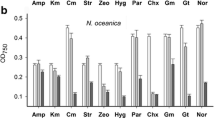Abstract
Significantly higher numbers of Gram-negative heterotrophic bacteria were present at the air-water interface (neston) of freshwater lakes than in the bulk water. Neuston bacteria were distinguished as a population distinct from bacteria in the bulk water by a higher incidence of pigmented colony types and significantly greater levels of multiple resistance to antibiotics and heavy metals. The incidence of plasmids in 236 neuston and 229 bulk water strains were similar (14 and 16.2%, respectively). Nine of 168 plasmid-free strains and 2 of 14 plasmid carrying strains, isolated from both bulk water and neuston, acted as recipients of plasmid R68.45 in plate matings with aPseudomonas aeruginosa donor strain PAO4032 at 21°C, but at frequencies below that of matings with a restriction-minus recipient strain ofP. aeruginosa, strain PAO1168. In a model system composed of nutrient-free synthetic lake water, plasmid R68.45 was shown to transfer betweenP. aeruginosa strains at frequencies between 10−3 and 10−5. Transconjugants were detected about 100 times more frequently at the interface than in the bulk water, which in part reflected a greater enrichment of the donor at this site. None of the aquatic isolates were able to act as recipients of plasmid R68.45 in this model system with strain PAO4032 as donor. The results suggest that under nutrient deprived conditions, the spread of plasmid R68.45 and similar plasmids by lateral transfer into this particular aquatic population would be a rare event.
Similar content being viewed by others
References
Bale MJ Fry JC, Day MJ (1987) Plasmid transfer between strains ofPseudomonas aeruginosa on membrane filters attached to river stones. J Gen Microbiol 133:3099–3107
Bale MJ, Fry JC, Day MJ (1988) Transfer and occurrence of mercury resistant plasmids in river epilithon. Appl Environ Microbiol 54:972–978
Blanchard DC, Syzdek LD (1981) Bubble scavenging of bacteria in freshwater quickly produces bacterial enrichment in airborne jet drops. Limnol Oceanogr 26:961–964
Blanchard DC Syzdek LD (1982) Water-to-air transfer and enrichment of bacteria in drops from bursting bubbles. Appl Environ Microbiol 43:1001–1005
Bradley DE, Whelan J (1985) Conjugation systems of IncT plasmids. J Gen Microbiol 131:2665–2671
Burton NF, Day MJ, Bull AT (1982) Distribution of bacterial plasmids in clean and polluted sites in a South Wales river. Appl Environ Microbiol 44:1026–1029
Collins VG (1963) The distribution and ecology of bacteria in fresh-water. Proc Soc Water Treat Exam 12:40–73
Gealt MA, Chai MD, Alpert KB, Boyers JC (1985) Transfer of plasmids pBR322 and pBR325 in wastewater from laboratory strains ofEscherichia coli to bacteria indigenous to the wastewater disposal system. Appl Environ Microbiol 49:836–841
Genthner FJ, Chatterjee P, Barkay T, Bourquin AW (1988) Capacity of aquatic bacteria to act as recipients of plasmid DNA. Appl Environ Microbiol 54:115–117
Haas D, Holloway BW (1976) R factor variants with enhanced sex factor activity. Mol Gen Genet 144:243–251
Hermansson M, Jones GW, Kjelleberg S (1987) Frequency of antibiotic and heavy metal resistance, pigmentation, and plasmids in bacteria of marine air-water interface. Appl Environ Microbiol 53:2338–2342
Jones JG, Gardener S, Simon BM, Pickup RW (1986) Aquatic resistance in bacteria in Windermere and two remote upland tarns in the English Lake District. J Appl Bact 60:443–453
Kado CI Liu S-T (1981) Rapid procedure for detection and isolation of large and small plasmids. J Bacteriol 145:1365–1373
King EO, Ward MK, Raney DE (1954) Two simple media for the demonstration of pyocyanin and fluorescin. J Lab Clin Med 44:301–307
Kjelleberg S, Stenstrom TA, Odham G (1979) Comparative study of different hydrophobic devices for sampling lipid surface films and adherent microorganisms. Mar Microbiol 53:21–25
Kjelleberg S, Humphrey BA, Marshall KC (1982) Effect of interfaces on small, starved marine bacteria. Appl Environ Microbiol 43:1166–1172
Kjelleberg S (1985) Mechanisms of bacterial adhesion at gas-liquid interfaces. In: Savage DC, Fletcher M (eds) Bacterial adhesion. Plenum Publication Corp, New York, pp 163–194
Kjelleberg S, Hermansson M, Marden P, Jones GW (1987) The transient phase between growth and nongrowth of heterotrophic bacteria, with emphasis on the marine environment. Annu Rev Microbiol 41:25–49
Klein TM, Alexander M (1986) Bacterial inhibitors in lake water. Appl Environ Microbiol 52:114–118
Krieg NR, Holt JG (ed) (1984) Bergey's manual of systematic bacteriology (volume 1). Williams and Wilkins, Baltimore, London
Norkrans B (1980) Surface microlayers in aquatic environments. Adv Microb Ecol 4:51–85
O'Morchoe SB, Ogunseitan O, Sayler GS, Miller RV (1988) Conjugal transfer of R68.45 and FP5 betweenPseudomonas aeruginosa strains in a freshwater environment. Appl Environ Microbiol 54:1923–1929
Rand MC, Greenberg AE, Taras MJ (ed) (1975) Standard methods for the examination of water and wastewater. American Public Health Association, American Water Works Association and Water Pollution Control Federation, 893 p
Rossman R (1980) Soluble elements concentrations and complexation in southeastern Lake Michigan. J Great Lakes Res 6:47–53
Stewart KR, Koditschek L (1980) Drug resistance transfer inEscherichia coli in New York Bight sediment. Mar Pollut Bull 11:130–133
Author information
Authors and Affiliations
Rights and permissions
About this article
Cite this article
Jones, G.W., Baines, L. & Genthner, F.J. Heterotrophic bacteria of the freshwater neuston and their ability to act as plasmid recipients under nutrient deprived conditions. Microb Ecol 22, 15–25 (1991). https://doi.org/10.1007/BF02540210
Received:
Revised:
Issue Date:
DOI: https://doi.org/10.1007/BF02540210




